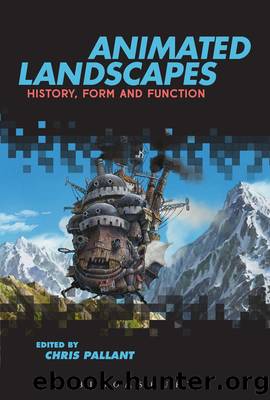Animated Landscapes by Chris Pallant

Author:Chris Pallant
Language: eng
Format: epub
Publisher: Bloomsbury
9
Off the Rails: Animating Train Journeys
Birgitta Hosea
In 2012 the average resident of the UK spent 361 hours travelling a total of 6,691 miles. Of this travel, 11 per cent was done by public transport.1 During their travels, the experience that these average residents have of landscape is in movement, of passing through places before arriving at their final destination. This is an important point to stress, as the mobility paradigm in urban geography and sociology proposes that cities and society can be studied in terms of travel rather than stasis – through the movement of peoples, resources, data, finance – in order to better understand the formation of identity, ideology, power and society.
In accord with these ideas about mobility, this chapter will focus on animations that move between locations and are concerned with trajectory and locomotion rather than landscape as a static entity. After considering the connections between early cinema and the train, we will examine a body of works that are all thematically linked through their association with animated train journeys, although the individual pieces of work may take different forms – from pre-filmic moving panoramas, to phantom rides, to Ivor the Engine, Thomas the Tank Engine, Madame Tutli-Putli, transport information films, post-filmic subway zoetropes and railway simulation games. Through a discussion of diverse approaches to animated – and animating – train journeys, this chapter will explore the implications of the mobility paradigm in urban geography for animation, not just in terms of visual content or subject matter, but in terms of animation as a concept and the politics of animation.
Landscape and the railway
It is no exaggeration to say that the advent of the railway fundamentally transformed the landscape. The thousands of miles of railway lines built all over the world traversed deserts, mountains, forests and prairies; the result of countless hours of backbreaking and sometimes fatal work blasting through rocks and exposing layers of ancient, geological time.2 Railway tracks, tunnels and bridges scarred the landscape and new station buildings were erected. In the United States, the construction of the Union Pacific Railroad through the territory of indigenous peoples led to raiding parties, sabotage, massacre and the displacement of the original inhabitants as well as the near extinction of vast herds of buffalo.3 The experience of the countryside was brought within the reach of town dwellers, as tourism and walking for leisure began to emerge as forms of leisure and the land began to lose its meaning as a purely functional resource to be bought, sold and to bear fruit, instead being reinterpreted as ‘landscape’, scenic, to be looked at and contemplated for leisure purposes.4 In our new millennium, it is easy to forget the extent of this feat of engineering and the impact that it had on people. Much smoother and faster than a horse-drawn carriage, the sustained speeds experienced in the journey by train were unprecedented and there was a seismic shift in the perception of speed. In 1830, the actress Fanny Kemble described her experience of
Download
This site does not store any files on its server. We only index and link to content provided by other sites. Please contact the content providers to delete copyright contents if any and email us, we'll remove relevant links or contents immediately.
Shoot Sexy by Ryan Armbrust(17142)
Portrait Mastery in Black & White: Learn the Signature Style of a Legendary Photographer by Tim Kelly(16484)
Adobe Camera Raw For Digital Photographers Only by Rob Sheppard(16387)
Photographically Speaking: A Deeper Look at Creating Stronger Images (Eva Spring's Library) by David duChemin(16161)
Bombshells: Glamour Girls of a Lifetime by Sullivan Steve(13108)
Art Nude Photography Explained: How to Photograph and Understand Great Art Nude Images by Simon Walden(12348)
Perfect Rhythm by Jae(4621)
Pillow Thoughts by Courtney Peppernell(3397)
The Book of Joy by Dalai Lama(3217)
Good by S. Walden(2915)
The Pixar Touch by David A. Price(2739)
Fantastic Beasts: The Crimes of Grindelwald by J. K. Rowling(2543)
A Dictionary of Sociology by Unknown(2518)
Humans of New York by Brandon Stanton(2379)
Read This If You Want to Take Great Photographs by Carroll Henry(2303)
Stacked Decks by The Rotenberg Collection(2270)
On Photography by Susan Sontag(2130)
Photographic Guide to the Birds of Indonesia by Strange Morten;(2088)
Insomniac City by Bill Hayes(2084)
